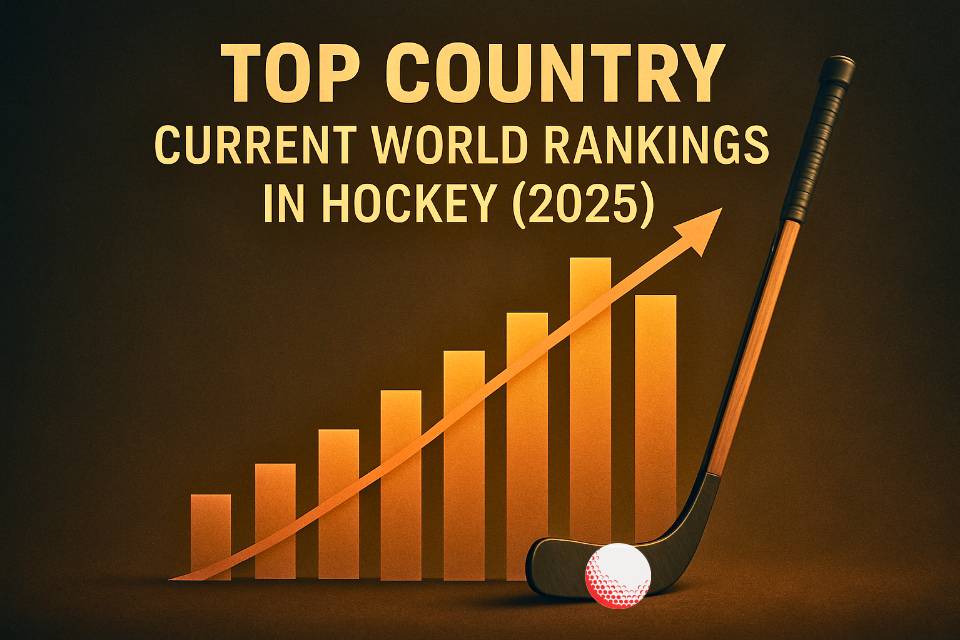Hockey, as a sport, takes on many exciting forms. Among them, field hockey vs ice hockey are the two most played and professionally followed versions. While both sports share a common name and some fundamentals, their styles, rules, equipment, and playing conditions differ significantly.
Played under the open sky on grassy or turf fields, field hockey contrasts with ice hockey, which is battled out on cold, frozen rinks. This 2025 updated comparison takes you deep into the histories, rule changes, player stats, and major global rankings of both versions.
History of Field Hockey and Ice Hockey
Let’s start with the history of field hockey and ice hockey:
Evolution of Field Hockey
The game legacy stretches back to antiquity, when early forms of field hockey appeared in Egyptian and Greek societies. The modern version was developed in 19th-century England, eventually becoming a structured competitive sport. By 1908, it was included in the Olympics (for men), and later in 1980 for women. Today, it is governed globally by the FIH (International Hockey Federation).
Evolution of Ice Hockey
During the 19th century in Canada, frozen lakes became playgrounds for British soldiers and locals who improvised early forms of ice hockey. The first organized indoor game took place in Montreal in 1875. By the early 20th century, ice hockey had become a popular winter sport and entered the Olympic scene in 1920. It is currently overseen by the IIHF (International Ice Hockey Federation) and the NHL in North America.
Field Hockey vs. Ice Hockey Rules
Ever wondered about the differences between field hockey and ice hockey? While both are thrilling sports centered around using a stick to propel an object into a net, their rules, playing environments, and game dynamics are distinct. Let’s break down what makes each sport unique.
Read More :- The Rise of Women Ice Hockey League: Global Growth, Challenges & Future
Field Hockey: Grass, Goals, and Strategic Play
Played on a grass or artificial turf pitch, field hockey is a non-contact sport emphasizing skill, strategy, and teamwork.
- The Pitch: Teams of 11 players (including a goalie) navigate a large field, aiming for goals only scorable from within a designated striking circle.
- The Stick & Ball: Players use a J-shaped stick, and crucially, only the flat side can contact the small, hard ball.
- Key Rules: You’ll see precise dribbling, passing, and shooting. Fouls like obstruction (blocking an opponent’s access to the ball) and dangerous play are penalized. There’s no offside rule, allowing for continuous attacking flow.
- Penalties: Most fouls outside the circle lead to a free hit. More serious infractions inside the circle can result in a penalty corner (a strategic set-piece) or even a penalty stroke (a one-on-one shot at the goalie).
Ice Hockey: Speed, Power, and Frozen Action
Ice hockey transforms the stick-and-object game into a high-octane spectacle on a frozen rink.
- The Rink: Each side has 6 players (a goalie, two defensemen, and three forwards) gliding across the ice on skates, constantly making on-the-fly substitutions.
- The Stick & Puck: Players wield an L-shaped stick to control a hard, rubber puck. Unlike in field hockey, players in ice hockey can strike the puck with either side of the stick and score from any spot on the rink.
- Key Rules: Body checking, which involves a well-timed physical challenge to dislodge the puck from an opponent, plays a vital role in the game. Strategic rules like offside (an attacking player can’t enter the offensive zone before the puck) and icing (shooting the puck too far down the ice) keep the game flowing strategically.
Field Hockey vs Ice Hockey: Key Differences Summarized
| Feature | Field Hockey | Ice Hockey |
| Playing Surface | Grass or synthetic turf | Ice rink |
| Ball/Puck | Hard plastic ball | Rubber puck |
| Footwear | Turf shoes or cleats | Ice skates |
| Players per Team | 11 players | 6 players (including goalie) |
| Game Duration | 4 quarters of 15 minutes each | 3 periods of 20 minutes each |
| Substitutions | Rolling substitutions allowed | Rolling substitutions allowed |
| Contact Level | Minimal body contact | Full body contact permitted |
| Scoring Method | Goals scored by hitting the ball into net | Goals scored by shooting puck into net |
| Protective Gear | Shin pads, mouthguard | Full gear including helmet, pads, gloves |
| Global Reach | Popular in Asia, Europe, Australia | Popular in North America, Northern Europe |
Top country Current World Rankings in Hockey (2025)
National team rankings by FIH are a reflection of long-term performance and dedication, calculated through continuous monitoring of international matches. The latest update, as of March 4, 2025, shows some clear leaders.

Men’s Field Hockey Top 10:
- Netherlands – Consistently a force, they hold the top spot.
- Belgium – A strong European contender, always pushing for the peak.
- England – Demonstrating solid performance to secure a high rank.
- Germany – A traditional hockey powerhouse that remains in the elite.
- India – Showing immense growth and skill, making them a significant threat.
- Australia – Always a competitive nation, holding their ground in the top tier.
- Spain – A European team steadily climbing the ranks.
- Argentina – Strong representatives from the Americas with a consistent presence.
- France – A rapidly improving team, breaking into the top 10.
- Ireland – Rounding out the top 10 with determined play.
Women’s Field Hockey Top 10:
- Netherlands – Unsurprisingly, they continue to set the standard in women’s field hockey.
- Argentina – Fierce competitors and perennial strong performers.
- Belgium – Making their mark with consistent high-level play.
- China – A rising power in the women’s game.
- Australia – A formidable team, always a contender.
- Germany – Showing strong results and maintaining a high position.
- Spain – Another European team performing well internationally.
- England – Consistently among the top teams.
- India – A strong Asian contingent with growing influence.
- New Zealand – A competitive side from Oceania, completing the top 10.
Ice Hockey: The Rink Dominators of 2025
The International Ice Hockey Federation (IIHF) rankings consider results from major tournaments over the past four years, including World Championships and Olympic Games. Take a look at where the top ice hockey nations rank globally as of May 2025:
Men’s Ice Hockey Top 10:
- Russia – Holding on to the top position in a race where every point counts.
- United States – Breathing down Russia’s neck, showcasing incredible talent.
- Switzerland – An impressive ascent, proving they are a top-tier nation.
- Canada – A perennial hockey powerhouse, always a dominant force.
- Sweden – Their unwavering excellence continues to earn them a spot in the elite top five.
- Czech Republic – Strong European contenders, known for their skill.
- Finland – Another Nordic nation with a deep hockey tradition.
- Germany – Continues to be a solid presence in international ice hockey.
- Denmark – Showing significant progress in recent years.
- Slovakia – Maintaining a respectable position among the world’s best.
Women’s Ice Hockey Top 10:
- United States – Currently holding the slight edge in a fierce North American rivalry.
- Canada – The other half of the dominant duo, always a threat for gold.
- Finland – The strongest European contender, consistently medaling.
- Czechia – A rapidly improving team making waves on the international stage.
- Switzerland – Demonstrating growing strength in the women’s game.
- Russia – A competitive team with strong players.
- Japan – A consistent performer from Asia, showcasing speed and skill.
- Sweden – A traditional hockey nation with a strong women’s program.
- Germany – Solidifying their position in the top ten.
- Hungary – A developing team that has made it into the top ranks.
Note:- All these rankings may change over time as the game continues and the rankings keep moving up and down according to the points
Conclusion
Though both field hockey and ice hockey are rooted in the same core concept of stick-and-goal gameplay, they are drastically different in execution. Field hockey thrives on tactical discipline, aerobic stamina, and strategic teamwork. Ice hockey, meanwhile, offers a faster, more physical, adrenaline-packed experience.
In 2025, both sports continue to grow and evolve, offering fans across the world two dynamic but very distinct experiences. Whether you enjoy the speed of skates or the rhythm of turf, both forms of hockey demand respect and offer their own kind of thrill.






